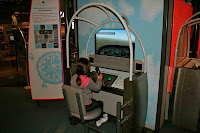First the context for this post on play
I recently had the opportunity to visit the Imperial War Museum at Duxford near Cambridge in England. I went with four of my grandchildren as well as my daughter and my wife. As a lover of planes I was excited to have the chance to visit this wonderful former WWI and WWII air base with many large hangars filled with over two hundred aircraft, as well as tanks, military vehicles and boats. The museum was opened in 2007 and has so many iconic aircraft, including the legendary Spitfire, Lancaster, Harrier and the fastest passenger plane ever, the joint British/French Concorde. But this is NOT a post about military weaponry!
The thing that impressed me most about the museum was the way the whole site was planned to involve children in learning. It does this using varied methods, including play. The result was that in our party of 7 people, two 60ish year-old adults, a 36 year old mother, three girls aged 2, 6 & 8, and a 10 year old boy all had a wonderful time and learned many things.
The use of play in learning
The main purpose of this post is to highlight how this exhibit used play so brilliantly. I was surprised just how much play was used. For example, IWM Duxford has one of the best playgrounds that I've ever seen. A playground for fun, but also a place to learn. The Air and Space building also uses a wide range of interactive mechanical, automated and scientific apparatus that teach children about aeronautics and basic physics. All the while children use these they are having great fun with many complex apparatus. It was obvious that the designers of this place understood the role of play in learning. Play was as important for my grandson as it was for three of my granddaughters aged 6, 8 and 2. For each of them play was instrumental to how they enjoyed and learned from the experience. What's more there were just as many adults enjoying the same scientific apparatus and having great fun.
 |
| Above: A basic experiment in air pressure |
The Playground
The playground just inside the entrance had just two items, a replica plane and a control tower connected by a simple acoustic telephone. This was the ultimate piece of playground equipment. Its setting next to the runway offered the opportunity for one of my granddaughters to pretend she was the flight controller, giving directions to her sister who was the pilot. At one stage a WWI Tiger Moth took off on the runway as she called instructions to her sister waiting on her own take off.
While this was all going on, my 2-year granddaughter was exploring every bit of the plane at a running pace. She was walking the balance beam to cross the open bomb window with safety net below, she ran to try her hand at the controls, the rear gunners station, she slid down the wings on the slippery dip and explored the numerous interactive pieces of equipment spread throughout the plane. At one stage she ran breathlessly past me and when I asked, "Are you having a good time" she called out:
'This is the best fun ever, ever, ever, ever, ever, ever, in every way'.
This playground was more than a place to run around and enjoy the usual slides and climbing ropes. This was a place to explore an aircraft on the edge of a famous runway before going inside to enjoy looking at planes and being involved in other interactive displays. Provision of knowledge was mixed with physical activity, kinaesthetic experience of parts of an aircraft modelled on the Spitfire and Lancaster bomber, and lots of fun!
Interactive Learning
 |
| Above: Sitting in the cockpit the pilot can speak to the control tower |
1. Have an understanding of what people of all ages find interesting.
2. Using varied methods for learning, including observation of iconic objects, provision of information in spoken and written word, image (picture, video, computer programs etc), discovery learning, use of sound, and the situating of learning in exciting contexts.
3. Providing evocative objects and places.
4. Offering opportunities for play, experimentation, hands on experiences and
 |
| Above: A great moment! As my granddaughters were communicating tower to pilot, a real Tiger Moth flew overhead |
Other Posts on Play & Discovery Learning
Posts on play HERE
Firsthand experience HERE
Creativity posts HERE




4 comments:
Good to hear such a positive comment about 'play' integrated with learning and confirmation of your grand daughter's statement that 'grandad was really excited'.
Learning activities have certainly improved over the years and sound really enjoyable.
Lynne
Thanks Lynne. Trevor
Hay I'm Glad you guys enjoyed it, im the chap who designed the thing.
Hi David, so glad to have your comment. The Duxford museum and the play equipment are brilliant. Well done! In fact the Duxford is a must see if people are in Britain and travel near Cambridge.
Post a Comment